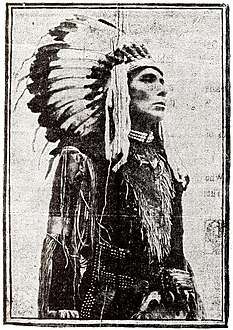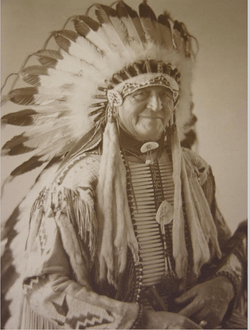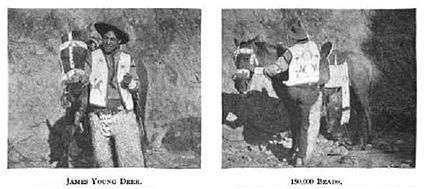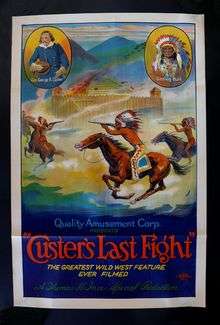Native Americans in film
The portrayal of Native Americans in films has varied throughout the 20th century, employing stereotypes that range from violent barbarians to noble and peaceful savages.[1] A variety of images appeared from the early to mid 1930s, and by the late 1930s negative images briefly dominated Westerns. But in 1950, the watershed movie Broken Arrow appeared that many credit as the first postwar Western to depict Native Americans sympathetically. Starting in the 1990s, Native American filmmakers have attempted to make independent films that work to represent the depth and complexity of indigenous peoples as people and provide a realistic account of their culture.[1]
History
- Early Native Americans in Film
 Dark Cloud (1855–1918), Native American film actor
Dark Cloud (1855–1918), Native American film actor Lillian Margaret St. Cyr (1873–1964), Native American film actress
Lillian Margaret St. Cyr (1873–1964), Native American film actress Edwin Carewe (1883–1940), the most prolific Native American director of feature films in Hollywood history
Edwin Carewe (1883–1940), the most prolific Native American director of feature films in Hollywood history Luther Standing Bear (1868–1939), Native American film actor
Luther Standing Bear (1868–1939), Native American film actor


_-_Moving_Picture_World_1920.jpg)
According to Beverly R. Singer, "Despite the fact that a diversity of indigenous peoples had a legal and historical significance in the formation of every new country founded in the Western Hemisphere, in the United States and Canada the term 'Indians' became a hegemonic designation implying that they were all the same in regards to culture, behavior, language, and social organization. The view of 'Indians' as savage and uncivilized was repeated in early films and crystallized the image of 'Indians' as dangerous and unacceptable to the normative lives of European immigrants whose lives appeared in films to be more valuable than those of the indigenous people they were colonizing."[2]
Early films featuring Native characters relied heavily on stereotypical depictions. These characters were often shown wearing leather clothing with feathers in their hair or with elaborate feather headdresses.[3] Further, Native communities were often depicted as cruel societies that sought out constant warfare and vengeance against white characters.[4] Individual Native characters were often written to be drunkards, humorless, cruel, or unintelligent.[5] These depictions, however, are generalized stereotypes and were used largely for aesthetic purposes. Specifically, the use of feather headdresses was culturally and historically correct for approximately only two dozen Plains tribes and not for the other Native societies depicted wearing them.[6]
Revisionist Western
The Revisionist Western, also known as a Modern Western or an Anti-Western, is a subgenre of Western films that began around the mid 1960s and early 1970s. This subgenre is characterized by a darker and more cynical tone that was generally not present in earlier Western films.
Revisionist Western films featuring Native characters
- Two Rode Together (1961)
- The Deadly Companions (1961)
- Hombre (1967)
- Tell Them Willie Boy is Here (1969)
- Soldier Blue (1970)
- Little Big Man (1970)
- Chato’s Land (1972)
- Buffalo Bill and the Indians (1976)
- The Missouri Breaks (1976)
- Dances With Wolves (1990)
- Dead Man (1995)
- The Missing (2003)
- The Only Good Indian (2009)
- The Lone Ranger (2013)
In the 1970s, Revisionist Westerns like Little Big Man and Soldier Blue often portrayed Native Americans as victims and white people as the frontier's aggressive intruders.[7] While the studio comedy Little Big Man still centers on a white protagonist, Dustin Hoffman, the Native Americans are depicted sympathetically while members of the United States Cavalry are depicted as villains. The Cheyenne in the film are living harmoniously and peacefully at the start of the film, and it's the encroachment of the violent white men who are the harmful, disruptive influence on their culture and landscape.[8] The film is also noted for including a Two-Spirit character as well as showing George Armstrong Custer as a lunatic – a fool and a fop – whom the white protagonist betrays for the sake of his adopted Indian family.[8]
The 1980s saw the emergence of independent films with contemporary Native content, such as Powwow Highway, a road movie and buddy film where one protagonist, an angry young activist, namechecks the American Indian Movement while the other visits sacred sites to greet the dawn, both on their way to free a friend from jail.[9]
1990's Dances with Wolves, while hailed by mainstream audiences and providing jobs for many Lakota actors, has also been cited as a return to the White savior narrative in film.[10] In the film U.S. soldiers capture John Dunbar (Kevin Costner) and take him as a prisoner. Native Americans race onto the scene and kill all of the U.S. soldiers while none of the Native Americans get killed. Some of them receive injuries, but they are portrayed as strong and immune to the pain. However, Dunbar then becomes part of the tribe, leads the Sioux against their rivals the Pawnee and later helps them escape the army he once served. The final credits of the film promote the false narrative that Sioux people are now extinct.[11]
Also in the 1990s, more Native Americans wrote, produced and directed their own projects, such as Chris Eyre's 1998 award-winning film, Smoke Signals, which has been selected for preservation in the National Film Registry for being "culturally, historically, or aesthetically significant".[12] It is one of few films featuring Native American characters that received a wide viewership.[13] Smoke Signals was written, directed, and acted in by Native Americans.[13] Like Powwow Highway, it is also a road movie and buddy film, that examines friendship, fatherhood, and the roles of tradition versus modernity in Indian Country.[14]
The New World offers a largely fictionalized retelling of the relationship between John Smith and Pocahontas. John Smith arrives to the Americas with the Pilgrims and is immediately captured by a Native American tribe. The movie perpetuates several myths about Pocahontas, changing her into an adult so the film can be made into a love story. In reality, Pocahontas was a child of about ten she met John Smith, and there is serious doubt as to whether any of the events he describes ever took place.[15][16]
Native Americans in animation
- Peter Pan (1953): Peter Pan is an 1953 animated film produced by Walt Disney. A major scene in Peter Pan involves the Darling children, Wendy, John and Michael Darling, the Lost Boys and Peter Pan celebrating at the Indian camp after Peter rescues Tiger Lily, the daughter of the chief, from Captain Hook and Mr. Smee. This scene features the song, "What Makes the Red Man Red?"
- Pocahontas (1995): Pocahontas is a 1995 Disney animated film. In this film, John Smith, while on the a voyage to Jamestown encounters Pocahontas and the Powhatan tribe. Conflict between the European settlers and Native Americans ensues, as tension ratches up between the two groups over land. Before a battle between the two groups begins, Pocahontas saves the life of John Smith and prevents the war. Though presented as historical, the story is highly fictionalised.
- Brother Bear (2003): Brother Bear is a 2003 animated film produced by Disney that follows the story of an Inuit boy named Kenai as he pursues the bear that killed his older brother, Sitka. However, his vengeance against the bear angers the Spirits. As punishment, the Spirits transform Kenai into a bear. In order to be human again, Kenai must travel to a mountain where the Northern lights touch the earth.
- Molly of Denali (2019): Molly of Denali is an animated series following the adventures of Molly, a 10-year-old Alaska Native, her friends Tooey and Trini, and her dog Suki. Molly of Denali is the first nationally distributed children's to feature an Alaska Native as the main character and protagonist.[17]
Documentaries
- Broken Rainbow (1985): Broken Rainbow details the forced relocation of the members of the Navajo tribe from Black Mesa, Arizona after the 1974 Navajo-Hopi Land Settlement Act.[18]
- Imagining Indians (1992): Imagining Indians is a 1992 documentary film produced and directed by Native American filmmaker, Victor Masayesva, Jr. (Hopi). The documentary attempts to reveal the misrepresentation of Indigenous culture and tradition in Classical Hollywood films through interviews with different Native actors and extras from various tribes throughout the United States.[19]
- The Canary Effect (2006): The Canary Effect is an examination of the effects of the United States and its policies on Indigenous communities.[20]
- Reel Injun (2009): Reel Injun is a 2009 Canadian documentary film directed by Cree filmmaker Neil Diamond, Catherine Bainbridge, and Jeremiah Hayes that explores the portrayal of Native Americans in film. Reel Injun is illustrated with excerpts from classic and contemporary portrayals of Native people in Hollywood movies and interviews with filmmakers, actors and film historians, while director Diamond travels across the United States to visit iconic locations in motion picture as well as American Indian history.[21]
- Inventing the Indian (2012): Inventing the Indian is a 2012 BBC documentary, initially broadcast on 28 October 2012, that explores the stereotypical view of Native Americans in the United States in cinema and literature.[22]
See also
- Native Americans in popular culture
- Native Americans in children's literature
- Racism in horror films
- Stereotypes about indigenous peoples of North America
References
- Boyd, Julia (Spring 2015). "An Examination of Native Americans in Film and Rise of Native Filmmakers" (PDF). The Elon Journal of Undergraduate Research in Communications. 6: 105–111.
- Beverly R. Singer: Native Americans and Cinema. In: Barry Keith Grant (ed. in chief): Schirmer Encyclopedia of Film: Volume 3: Independent Film–Road Movies. Farmington Hills, MI: Schirmer Reference, 2007, pp. 211–214, [212].
- Price, John A. (1973). "The Stereotyping of North American Indians in Motion Pictures". Ethnohistory. 20 (2): 153–171. doi:10.2307/481668. ISSN 0014-1801. JSTOR 481668.
- Price, John A. (1973). "The Stereotyping of North American Indians in Motion Pictures". Ethnohistory. 20 (2): 153–171. doi:10.2307/481668. ISSN 0014-1801. JSTOR 481668.
- Price, John A. (1973). "The Stereotyping of North American Indians in Motion Pictures". Ethnohistory. 20 (2): 153–171. doi:10.2307/481668. ISSN 0014-1801. JSTOR 481668.
- Price, John A. (1973). "The Stereotyping of North American Indians in Motion Pictures". Ethnohistory. 20 (2): 153–171. doi:10.2307/481668. ISSN 0014-1801. JSTOR 481668.
- Aleiss, Angela (2005). Making the White Man's Indian: Native Americans and Hollywood Movies. Praeger Publishers. pp. 1–57, 119–140.
an indian love story 1911.
- Rollins, Peter (2011). Hollywood's Indian: The Portrayal of the Native American in Film. University Press of Kentucky. pp. 121–136. ISBN 978-0813131658.
- Ebert, Roger, "Powwow Highway" for the Chicago Sun-Times. 28 April 1989. Archived at Digital Chicago, Inc.
- Goff, Keli (May 4, 2014). "Can 'Belle' End Hollywood's Obsession with the White Savior?". The Daily Beast. Retrieved May 14, 2014.
- Dances with Wolves. Dir. Kevin Costner. Tig Productions. Orion Pictures, 1990. Film.
- "'Jurassic Park', 'Shining' added to National Film Registry". Associated Press. December 12, 2018. Retrieved December 12, 2018.
- Domínguez, Daisy (2014). "American Indians in Feature Films: Beyond the Big Screen". CUNY Academic Works.
- Thomas, Kevin (26 June 1998). "Smoke Signals: Stylish 'Signals' a Bittersweet Comedy About Friendship". Los Angeles Times. Retrieved 11 April 2018.
- "A Guide to Writing about Virginia Indians and Virginia Indian History" (PDF). Commonwealth of Virginia, Virginia Council on Indians. January 2012. Archived from the original (PDF) on February 24, 2012. Retrieved April 18, 2019.
- The New World. Dir. Terrence Malick. New Line Cinema, 2006.
- "PBS KIDS Announces MOLLY OF DENALI, Premiering July 15, 2019". PBS About. Retrieved 2019-11-18.
- Goodman, Walter (1986-04-11). "Film: 'Broken Rainbow', Documentary". The New York Times. ISSN 0362-4331. Retrieved 2019-11-18.
- "Imagining Indians". Documentary Educational Resources Online Store. Retrieved 2019-11-18.
- "The Canary Effect | Tribeca Film Festival". Tribeca. Retrieved 2019-11-18.
- "Reel Injun: Native Americans Portrayal in Hollywood". Independent Lens. PBS. Retrieved 2019-11-18.
- "BBC Four - Rich Hall's Inventing the Indian". BBC. Retrieved 2019-11-18.
Further reading
- Native Americans on Network TV (2013)
- Aleiss, Angela (2005). Making the White Man's Indian: Native Americans and Hollywood Movies. Westport, Conn./London: Praeger. ISBN 0-275-98396-X.
- Simmon, Scott (June 30, 2003). The Invention of the Western Film: A Cultural History of the Genre's First Half Century. New York: Cambridge University Press. ISBN 0-521-55581-7.